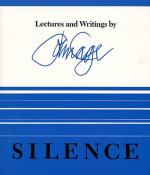
|
| Name: _________________________ | Period: ___________________ |
This test consists of 5 multiple choice questions, 5 short answer questions, and 10 short essay questions.
Multiple Choice Questions
1. "Edgard Varese" was first published in what city?
(a) New York City.
(b) Paris.
(c) Stockholm.
(d) Madrid.
2. What composer wrote "Intersection 3"?
(a) Morton Feldman.
(b) Earle Brown.
(c) Julius Eastman.
(d) Christian Wolff.
3. In the "Definitions" section of "Forerunners of Modern Music," what term is "the means of controlling the continuity from note to note"?
(a) Form.
(b) Method.
(c) Material.
(d) Structure.
4. "Imaginary Landscape No. 4" was written for how many radios?
(a) 12.
(b) 15.
(c) 11.
(d) 8.
5. In the "Strategy" section of "Forerunners of Modern Music," what term does Cage say "is properly mind-controlled"?
(a) Method.
(b) Structure.
(c) Material.
(d) Form.
Short Answer Questions
1. According to Cage, it would be act of charity for people to do what when they come across Erik Satie's records?
2. Yun Kiang met a man who acted like what animal?
3. A portion of "Composition as Process--3: Communication" was published in what publication?
4. In the "Definitions" section of "Forerunners of Modern Music," what term is "content, the continuity"?
5. According to Cage, who had probably never given Erik Satie a thought?
Short Essay Questions
1. Why did Cage allow his creations to be called "experimental" after once resisting the title?
2. How does Cage describe the creation of "Music for Piano"?
3. Describe what Cage said about the French and the Italians in a conversation he recalls having at a Venetian restaurant.
4. What is the purpose of the section in "Composition as Process--III: Communication" where the author answers questions with more questions?
5. How does Cage describe the way Christian Wolff wrote music?
6. What does Cage say about being associated with Dadaism and Zen in his Foreword?
7. What does Cage comment on in the article "Forerunners of Modern Music"?
8. Describe the anecdote used at the conclusion of "Composition as Process--2: Indeterminacy" about Dr. Suzuki.
9. What advancements in music does Cage attribute to Henry Cowell?
10. How has Cage's process of composition evolved?
|
This section contains 736 words (approx. 3 pages at 300 words per page) |

|




